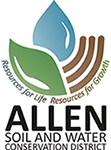Field Windbreak Program
A windbreak, or shelterbelt, is usually made up of one or more rows of trees or shrubs planted in such a manner as to provide shelter from the wind and to prevent soil from erosion. They are commonly planted around the edges of fields on farms. If designed properly, windbreaks around a home can reduce the cost of heating and cooling and save energy. Windbreaks are also planted to help keep snow from drifting onto roadways and even yards. Other benefits include providing habitat for wildlife and in some regions the trees are harvested for lumber.
A further use for a windbreak is to screen a farm from a main road or motorway. This improves the farm landscape by reducing the visual incursion of the motorway, reducing noise from the traffic and providing a safe barrier between farm animals and the road.
For 34-cents per row foot, the ODNR Division of Forestry personnel will provide and plant the trees and apply herbicide. A second dormant herbicide will be made in the fall, or the next growing season. A qualifying windbreak must be planted in or adjacent to agricultural land in a field of at least ten acres in size. Cost-share assistance for installation is available through the CREP program.

